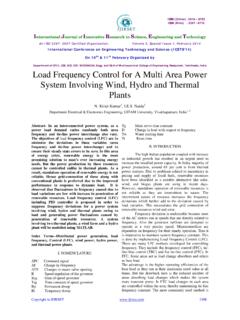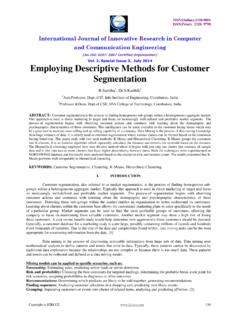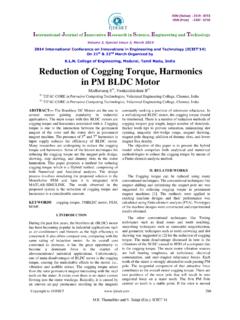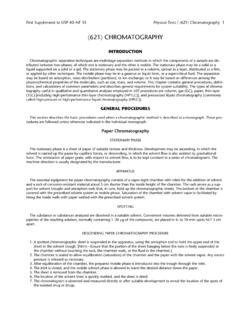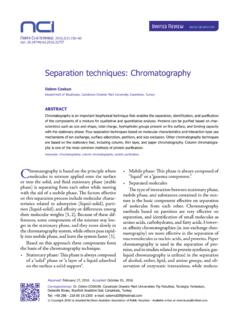Transcription of A Review on High Performance Liquid Chromatography …
1 Research & Reviews: Journal of Pharmaceutical Analysis 22 e-ISSN: 2320-0812 p-ISSN: 2347-2340 RRJPA | Volume 5 | Issue 2 | July September, 2016 A Review on high Performance Liquid Chromatography ( hplc ) Mukthi Thammana* Department of Pharmacy, Vignan Institute of Pharmaceutical Technology, Duvvada, Visakhapatanam, Andhra Pradesh, India Review Article Received: 26/09/2016 Accepted: 30/09/2016 Published: 03/10/2016 *For Correspondence Mukthi Thammana, Department of Pharmacy, Vignan Institute of Pharmaceutical Technology, Visakhapatnam, Andhra Pradesh, India E-mail: Keywords: Chromatography , Mobile phase, Stationary phase, Analyte ABSTRACT Chromatography is defined as a set of techniques which is used for the separation of constituents in a mixture.
2 This technique involves 2 phases stationary and mobile phases. The separation of constituents is based on the difference between partition coefficients of the two phases. The Chromatography term is derived from the greek words namely chroma (colour) and graphein (to write). The Chromatography is very popular technique and it is mostly used analytically. There are different types of chromatographic techniques namely Paper Chromatography , Gas Chromatography , Liquid Chromatography , Thin Layer Chromatography (TLC), Ion exchange Chromatography and lastly high Performance Liquid Chromatography ( hplc ). This Review mainly focuses on the hplc technique its principle, types, instrumentation and applications.
3 INTRODUCTION high Performance Liquid Chromatography which is also known as high pressure Liquid Chromatography . It is a popular analytical technique used for the separation, identification and quantification of each constituent of mixture. hplc is an advanced technique of column Liquid Chromatography . The solvent usually flows through column with the help of gravity but in hplc technique the solvent will be forced under high pressures upto 400 atmospheres so that sample can be separated into different constituents with the help of difference in relative affinities [1-7]. In hplc , pumps will be used to pass pressurized Liquid solvent including the sample mixture which is allowed to enter into a column filled with solid adsorbent material.
4 The interaction of each sample component will be varies and this causes difference in flow rates of each component and finally leads to separation of components of column. Chromatography can be depicted as a mass exchange process including adsorption. hplc depends on pumps to pass a pressurized fluid and an example blend through a section loaded with adsorbent, prompting the partition of the specimen segments. The dynamic segment of the section, the adsorbent, is regularly a granular material made of solid particles ( silica, polymers, etc.) 2 m to 50 m in size. The segments of the example mixture/blend are isolated from each other because of their distinctive degrees of connection with the retentive particles.
5 The pressurized fluid is commonly a blend of solvents ( water, acetonitrile and/or methanol) and is known as mobile phase . Its organization and temperature plays an important part in the partition procedure by affecting the connections occurring between sample segments and adsorbent [8-15]. hplc is recognized from traditional ("low weight") Liquid Chromatography because operational pressures are fundamentally higher (50 bar to 350 bar), while normal Liquid Chromatography regularly depends on the power of gravity to pass the portable stage through the segment. Because of the small sample amount isolated in scientific hplc , column section measurements are mm to mm distance across, and 30 mm to 250 mm length.
6 Additionally, hplc segments are made with smaller sorbent particles (2 m to 50 m in normal molecule size). This gives hplc high determining or resolving power (the capacity to recognize components) while isolating mixtures, which makes it a prominent chromatographic method [16-25]. Research & Reviews: Journal of Pharmaceutical Analysis 23 e-ISSN: 2320-0812 p-ISSN: 2347-2340 RRJPA | Volume 5 | Issue 2 | July September, 2016 HISTORY Preceding hplc researchers utilized standard Liquid chromatographic methods. Liquid chromatographic systems were to an inefficient because of the flow rate of solvents being reliant on gravity. Separations took numerous hours, and some of the time days to finish.
7 Gas Chromatography (GC) at the time was more effective than Liquid Chromatography (LC), in any case, it was trusted that gas stage partition and investigation of extremely polar high atomic weight biopolymers was impossible. GC was ineffectual for some organic chemists due to the thermal instability of the solutes. Accordingly, alternative techniques were hypothesized which would soon bring about the advancement of hplc . Taking after on the original work of Martin and Synge in 1941, it was anticipated by Cal Giddings, Josef Huber, and others in the 1960s that LC could be worked in the high -proficiency mode by decreasing the pressing molecule measurement generously beneath the run of the mill LC (and GC) level of 150 m and utilizing pressure to expand the versatile stage velocity.
8 These expectations experienced broad experimentation and refinement all through the 60s into the 70s. Early developmental exploration started to enhance LC particles, and the innovation of Zipax, an externally permeable molecule, was promising for hplc technology. The 1970s achieved numerous advancements in equipment and instrumentation. Specialists started utilizing pumps and injectors to make a simple configuration of a hplc system. Gas amplifier pumps were perfect since they worked at consistent pressure and did not require release free seals or check valves for steady flow and great quantitation. While instrumentational advancements were important, the historical backdrop of hplc is principally about the history and development of molecule technology.
9 After the presentation of permeable layer particles, there has been a steady pattern to reduced molecule size to enhance efficiency. However, by decreasing molecule size new issues arrived. The disadvantage from the unnecessary pressure drop is expected to drive versatile Liquid through the segment and the trouble of setting up a uniform pressing of to a great degree fine materials. Every time molecule size is diminished altogether, another round of instrument advancement normally should occur to handle the pressure . OPERATION The sample blend to be isolated and dissected is presented, in a discrete little volume (commonly microliters), into the stream of mobile phase permeating through the column.
10 The segments of the sample travel through the segment at various speeds, which are a component of particular physical connections with the adsorbent (likewise called stationary stage). The velocity of every component relies on upon its compound nature, composition of mobile phase. The time at which a particular analyte elutes (rises up out of the column) is called its retention time. The retention time measured under specific conditions is a distinguishing normal for a given analyte [26-36]. Various sorts of columns are available, loaded with adsorbents varying in molecule size, and in the nature of their surface ("surface science"). The utilization of small molecule size packing materials requires the utilization of higher operational pressure ("backpressure") and regularly enhances chromatographic resolution ( the degree of division between sequential analytes rising up out of the column).

